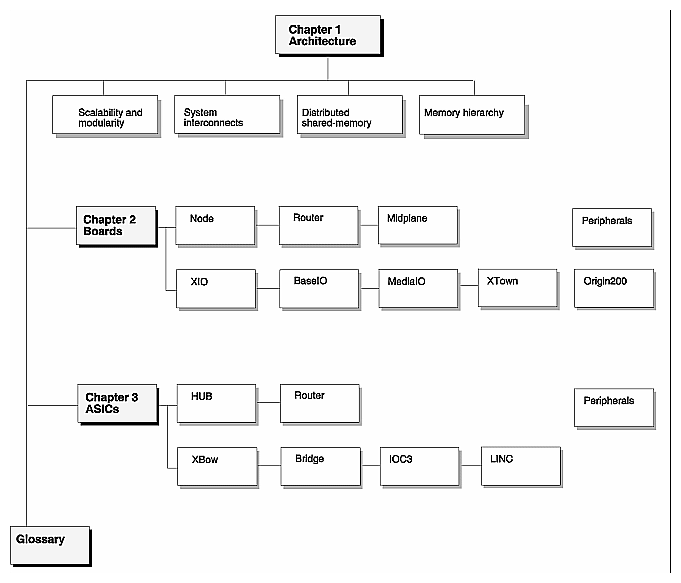This document is a brief and practical orientation to the Origin2000™ system. It is intended for SSEs and customers who need background for Origin2000 installation and diagnostic tasks. The information contained in this document is organized as follows:
Front matter
Contents
List of Figures
List of Tables
About This Guide, which describes the organization of the manual, references, and typographical conventions
Chapter 1, which gives an overview of the Origin™ architecture
Chapter 2, which gives a board-level description
Chapter 3, which gives an ASIC-level description
The figure on the next page illustrates this organization pictorially.
Much of the explanatory material in this book was taken from three canons:
Lenoski, Daniel and Weber, Wolf-Dietrich. Scalable Shared-Memory Multiprocessing San Francisco: Morgan Kauffman, 1995.
Hennessy, John and Patterson David. Computer Architecture: A Quantitative Approach San Mateo, California: Morgan Kauffman, 1990.
Schimmel, Curt. Unix Systems for Modern Architectures Menlo Park, California: Addison Wesley, 1994.
James Laudon's System Specification and Cache Coherence Protocol Specification provided a wealth of information. Both are internal-Silicon Graphics® documents.
The following information was also relevant:
Kourosh Gharachorloo, Daniel Lenoski, James Laudon, Phillip Gibbons, Anoop Gupta, and John Hennessy. Memory Consistency and Event Ordering in Scalable Shared-Memory Multiprocessors. Proceedings of the 17th International Symposium on Computer Architecture, pages 15-26, May 1990.
ftp://www-flash.stanford.edu/pub/flash/ISCA90.ps.Z
Kourosh Gharachorloo, Anoop Gupta, and John Hennessy. Revision to Memory Consistency and Event Ordering in Scalable Shared-Memory Multiprocessors. Technical Report CSL-TR-93-568, Computer Systems Laboratory, Stanford University, April 1993.
ftp://www-flash.stanford.edu/pub/flash/ISCA90_rev.ps.Z
Daniel Lenoski, James Laudon, Truman Joe, David Nakahira, Luis Stevens, Anoop Gupta, and John Hennessy. The DASH Prototype: Implementation and Performance. In Proceedings of the 19th International Symposium on Computer Architecture, pages 92-103, Gold Coast, Australia, May 1992.
http://www-flash.stanford.edu/architecture/papers/paperlinks.html
Thanks also to Ben Passarelli, Rick Bahr, Rich Altmaier, Ben Fathi, Ed Reidenbach, Rob Warnock, Jim “Positive-ECL” Smith, Sam Sengupta, Dave Parry, Robert A. dePeyster, Mike Galles, and Luis Stevens.
Finally, thanks to John Mashey (mash@mash.sgi.com) for making himself iteratively available during various emergencies.
is used for emphasis
is used for bits, fields, and registers important from a software perspective (for instance, address bits used by software, programmable registers, etc.)
The following documents provide additional information about the Origin and Onyx2™ systems:
Origin and Onyx2 Programmer's Reference Manual, part number 007-3410-nnn
IRIX Device Driver Programmer's Guide, part number 007-0911-nnn
Origin2000 Deskside Server Owner's Guide, part number 007-3453-nnn
Origin2000 Rackmount Owner's Guide, part number 007-3456-nnn
Onyx2 Deskside Workstation Owner's Guide, part number 007-3454-nnn
Origin200 Owner's Guide, part number 007-3415-nnn
Some of these can be found on the Technical Publications web site,
http://www.sgi.com/Technology/TechPubs/
